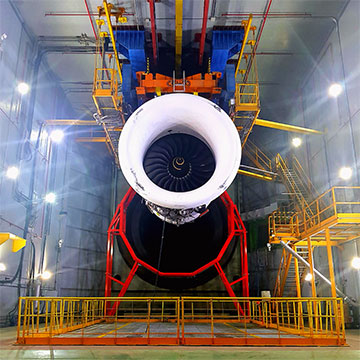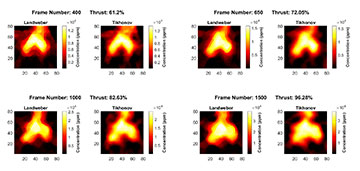
UK researchers have developed a new imaging technique, chemical species tomography, to image carbon dioxide emissions from commercial jet engines. The imaging setup includes a 7-m-diameter optical mounting frame (red) 3 m from the engine exhaust nozzle. [Image: G. Humphries, University of Strathclyde]
Engineers from several UK instrumentation groups have worked together to develop and demonstrate a near-infrared (NIR) imaging technology for viewing carbon dioxide emissions in commercial jet-engine exhaust plumes (Appl. Opt., doi: 10.1364/AO.467828). The images provide real-time, spatially resolved carbon dioxide emissions data that could inform combustion research and designs for more environmentally friendly turbines and fuels.
“This information has not been available before at this industrial scale and is a big improvement over the current industry-standard emissions measurement, which involves taking gas from the exhaust to a gas analyzer system in a different location,” said team leader Michael Lengden, University of Strathclyde, UK.
Chemically specific imaging
Lengden and his colleagues describe their imaging technique, chemical species tomography, as similar to a computed tomography scan one would get at a hospital. However, instead of using X-rays to image the body, the UK researchers use 126 beams of NIR light to image a commercial jet engine at work.
The NIR light beams are directed through and around the plume of gas from an active jet engine. The light is tuned to the absorption wavelength of the target molecule—around 1999 nm for carbon dioxide—in jet fuel when it is burned.
The engineers employed tunable diode laser spectroscopy with wavelength modulation to measure the absorption spectra which were then recorded in a quasi-simultaneous mode at 1.25 and 0.3125 Hz frame rates and processed into images with a novel computer algorithm.
Viewing carbon dioxide in an exhaust plume
To test their imaging technology, the engineers constructed a special facility to measure commercial airplane engine emissions at the Instituto Nacional de Técnica Aeroespacial in Madrid, Spain.
The engineers arranged imaging components on a 7-m-diameter frame 3 m away from the engine nozzle to capture an area of about 1.5 m in diameter with a spatial resolution of 60 mm. For their demonstrations, they used a Rolls-Royce Trent gas engine turbine with a ring of fuel injectors—an engine commonly used in long-haul flights.
At all thrust levels, a ring structure of carbon dioxide concentration can be seen in the center of the engine using chemical species tomography. [Image: A. Upadhyay et al., Appl. Opt., doi: 10.1364/AO.467828 (2022)] [Enlarge image]
A computer algorithm produced images of chemical species from each of the 126 NIR light beams’ absorption data. The images revealed a ring-shaped concentration of carbon dioxide in the middle of the engine at all levels of thrust, as well as a concentration of carbon dioxide in the middle of the exhaust plume, most likely due to the engine’s boat tail.
The nearly immediate images produced by the unobtrusive chemical species tomography imaging method could, the researchers believe, be leaps and bounds better than the current practice of using gas chromatography to analyze samples of extracted gaseous emissions from engines. The chromatography method is highly intrusive and provides a limited spatial resolution of the exhaust.
Next steps
Now, the engineers are working on a new instrument to measure other combustion chemicals present in aviation and industrial power generation engines, including nitrogen oxides, water, carbon monoxide and oxygen. Not only do they hope their new imaging platform leads to more fuel-efficient engine designs, but they also hope it will improve knowledge of the combustion process in general.
“The aviation industry is a major contributor to global carbon dioxide emissions, so there is a need for turbine and fuel technologies to improve radically,” added Lengden. “By providing fully validated emissions measurements, our new method could help the industry develop new technology that reduces the environmental impact of aviation.”

